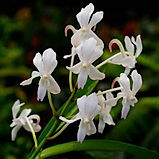Neostylis Lou Sneary White
Neostylis Lou Sneary White is a primary hybrid between Neofinetia Falcata and Rhynchostylis Coelestis. Plants are vandaceous and may bloom multiple times each year. They generally flower in June and July and have a very sweet fragrance similar to the Jasmine that is strongest at dusk and dawn. It is the first orchid ever to be grown as a house plant in Japan in the 1600s, which is also known as the Samurai Orchid. They generally flower in June and July and have a very sweet fragrance similar to the Jasmine.
CARE key
GENUS
VANDACHOSTYLIS
TYPE
PRIMARY HYBRID
NATIVITY
THAILAND

ELEVATION
100 - 800 M





DECODING FOOT CANDLES(fc):
A foot-candle, is a measurement of light intensity. One foot-candle is defined as enough light to saturate a one-foot square with one lumen of light. Rather than measuring the amount of light that leaves a light source (lumen output), foot-candle measurements focus on the amount of light that reaches a surface area. Well, lets not get too much technical.
Let's understand it quickly with some comparisons,
-
Typical foot-candle reading for unobstructed sunlight - 10,000 fc ( imagine you are at the beach under clear sky )
-
Sunshine on a cloudy day - 100 fc ( imagine a day when you feel its about to rain but there is diffused sunshine )
-
Residential space (living) - 5-40 fc ( when your doors and windows are shut as you are using air conditioner )
That means, when we use a 50% shade net under the clear sky conditions, it is around 5000 fc that the surface receives. Under all weather conditions the 50% shade net on an average will allow 2500 - 3000 fc to fall on a square-foot of surface area.
And for those who have a lux meter (light meter) at home, remember that One foot-candle equals 10.76 lumens/lux.
UNDERSTANDING RELATIVE HUMIDITY:
Relative humidity is the ratio of how much water vapour is in the air and how much water vapour the air could potentially contain at a given temperature. It varies with the temperature of the air: colder air can hold less vapour. So changing the temperature of air can change the relative humidity.
Relative humidity is normally expressed as a percentage; a higher percentage means that the air–water mixture is more humid. At 100% relative humidity, the air is saturated.
Relative humidity only considers the invisible water vapour. Mists, clouds, fogs and aerosols of water do not count towards the measure of relative humidity of the air.
IMPORTANT NOTE:
-
The factual information given on dynamic variable such as watering is irrespective of the media used for planting the orchid. That is, Imagine that the watering frequency given above is for a bare rooted specimen of this variety. Therefore, this watering frequency varies and has to be followed in accordance with the media used. More the quick drying tendency of the media more frequent the watering shall be. For example, charcoal/wood dries quicker than coconut husk/sphagnum Moss.
-
The elevation (above sea level) provided is to understand the level of Humidity available at the original natural habitat of the particular Species or Hybrid. Generally, higher the altitude, lesser will be the natural levels of relative humidity available for your plant to utilise. Thus, there might be a need to improve humidity artificially.
-
The best things about orchids are, these wonders are capable of adapting to any extreme changes in weather conditions provided their time, energy and initial support to assimilate to the new growing conditions. Thus there is no universal care guide for Orchid care. Their potency cannot be contained within these generalisations and the factual information. But we hope these details help you understand the basic requirements and natural demand of a particular Species or Hybrid.
DISCLAIMER
Except as permitted by the copyright law applicable to you, you may not reproduce or communicate any of the content on this page, including files downloadable from this website, without the permission of the copyright owner.
© Guna Orchids [2019-2022]. All Rights Reserved.

